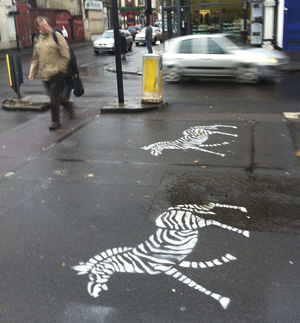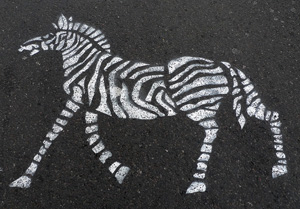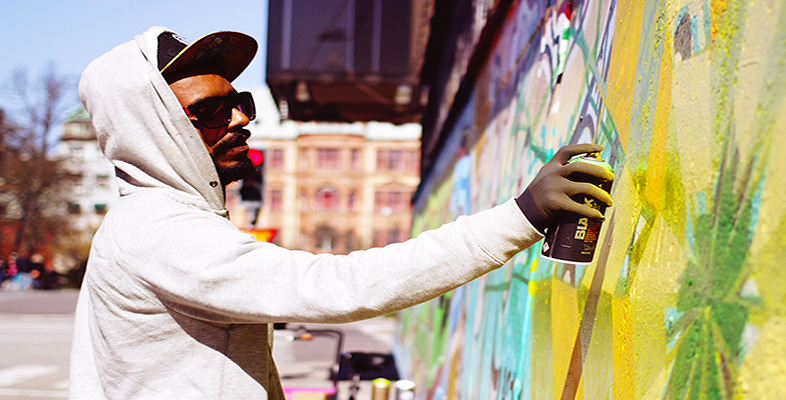6 Graffiti as a form of popular protest
The following case study illustrates how graffiti has been used as an articulation of popular public protest. In 2010, anonymous activists sprayed stencilled zebras on the surface of a road in the London borough of Hackney to draw public attention to a previously unsuccessful seven year long campaign and online petition for a safe pedestrian crossing at a notoriously dangerous junction.


Activity 4 ‘Mystery zebras’
Question 1
Watch the following short film ‘Hackney’s mystery zebras uncovered’, which shows how the graffiti was made, what motivated activists to make these graffiti and how people responded to them. The activists’ voices are altered and their faces covered as they do not want to be identified. While watching this short film, bear in mind the following questions and note your responses in the text boxes below.
- What effects do the ‘Hackey Zebra’ graffiti have on:
- you
- the people shown in the video?
- How were the ‘Hackey Zebras’ made? What techniques are used in their production?
- What does the video say about the wider context within which the ‘Hackeney Zebra’ graffiti were made, and why they were made?
- What do the creators of the graffiti say about the intended meaning of the ‘Hackney Zebra’ graffiti?
Tip:
Making notes at the same time as you are watching or listening can be tricky as you are likely to miss something. Try watching the whole video first. Jot down very briefly what you noticed that you want to capture next time. Then watch any sections you want to focus on again
Transcript: Video: Hackney’s mystery zebras uncovered
[SIREN]
- What effects do the ‘Hackey Zebra’ graffiti have on:
- you
- the people shown in the video?
Discussion
The answer is personal to you and there are many different ways of approaching this task. Here is what a member of the course team thought:
The ‘Mystery zebras’ made me smile. I regard this graffiti as an example of an amusing and clever way of expressing protest, and I am also impressed by the courage of the protesters (feel free to disagree!).
The video also says something about the wider effects of this graffiti. It shows the artists being chased by the police with blue flashing lights and sirens. The video suggests that they were caught by the police, but it is not clear what the end result of this was (that is, whether they were arrested and/or fined). Even though the graffiti caused enough concern to the police to chase (and possibly arrest) the artists, it is also clear that the graffiti was widely welcomed by local residents (judging by the information provided in the video). The video captures a range of reactions by pedestrians, car drivers and cyclists who all respond very positively to the graffiti that mysteriously appeared overnight. The graffiti zebras draw attention to the junction and the badly-needed zebra crossing. People are also pleased with the visual effect of the graffiti and its implicit humour, given that the graffiti is in the shape of zebras, rather than the black and white stripes of an actual zebra crossing. They describe the graffiti as ‘amazing’, ‘brilliant’, ‘really cool’, ‘lovely’, ‘so nice’ and as ‘brighten[ing] up a rainy day’.
- How were the ‘Hackey Zebras’ made? What techniques are used in their production?
Discussion
The video shows the artists/activists drawing and cutting out a cardboard stencil of a zebra. At night, they put the stencil on the road and use white spray paint to spray several zebras onto the black road surface.
Question 2
- What does the video say about the wider context within which the ‘Hackeney Zebra’ graffiti were made, and why they were made?
Discussion
This particular example of graffiti was created in the context of a campaign to improve pedestrians’ safety in Hackney, which had previously not been successful. Campaigners were looking for a way to make ‘people’s voices heard’ and convince TfL (Transport for London) to install a safe pedestrian crossing at this particular junction.
Question 3
- What do the creators of the graffiti say about the intended meaning of the ‘Hackney Zebra’ graffiti?
Discussion
The artists/activists explain that they chose the zebra graffiti as they perceive it as an effective way of communication that does not ‘hurt … anyone’, is ‘immediately recognisable’ and ‘so simple’. They want to take charge and ‘reclaim the streets’ by making their ‘own zebra crossing’.
In response to the appearance of the mystery graffiti zebra on the road surface of this junction, Transport for London (TfL) was finally convinced to install an official zebra crossing there.
